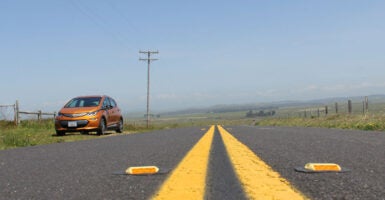Temperatures are over 100 degrees this month in Twin Falls, Idaho, sapping the distance electric vehicles can travel.
EVs in the Gem State remain relegated to the back seat when it comes to consumers’ choice in vehicles, despite a new Environmental Protection Agency mandate requiring that 70% of new cars sold be all electric by 2032. Idaho had 8,000 registered EVs in 2023, compared to 60,000 and 140,000 in neighboring Oregon and Washington, respectively.
At the Twin Falls Toyota dealership, sales manager Scott Mason said that he could count on one hand the number of fully electric vehicles Toyota has sold in the area. In fact, no fully electric vehicles were available on the lot.
Kent Atkin, project manager at J-U-B Engineers, described how battery-powered EVs “just don’t fit” with life in southern Idaho. His biggest focus as an engineer is the health and safety concerns caused by the unreliability of EVs under extreme temperatures. He said, “We’re expecting people to get stuck in extreme heat and cold. At 105-degree heat in the desert, if you’re stuck out there, you’re done. We’re used to reliability for safety in Idaho.”
EVs cannot match the performance of gas-powered vehicles in extreme weather. Southern Idaho’s wind chill pulls the temperature down to single digits every winter, and summers routinely reach over 100 degrees Fahrenheit. This weather means that battery-powered electric vehicles fail to achieve their promised range and can leave drivers stranded.
Under extreme cold, batteries use stored-up charge to heat themselves rather than saving the charge for driving. In below-freezing conditions, batteries experience up to 40% range loss.
Under extreme heat, battery ions move faster. As that happens, pressures inside batteries build, creating micro-cracks that permanently decrease battery life and range. With freeway speed limits of 80 mph, batteries pull power faster to keep up with the demands of the roads and, when combined with unpredictable weather, can lose power before reaching the driver’s destination.
Gas-powered cars can handle temperature extremes and guarantee ranges long enough to transport people from one gas station to another, while an EV cannot do this considering how remote charging stations are in rural areas.
Extreme temperatures also affect charging speeds. When drivers plug EVs into chargers, cold weather prompts internal battery heaters to run. This pulls a quarter of charging power away from the battery itself and directs it to attached heaters. If the battery’s sensors detect that the battery temperature is anything less than minus 13 degrees Fahrenheit and the EV is charging, all power will go to the heater, and the EV will not charge until temperatures rise. This is a substantial disadvantage compared to gas vehicles that can refill in five to 10 minutes.
Charging stations in the Gem State are few and far between, with long stretches of remote roads or busy freeways between them. Twin Falls offers 25 public EV charging stations and is about 120 miles from the nearest cities with charging stations. As Atkin remarked later in our call, “If everyone had to drive an EV, they couldn’t” with the current infrastructure.
Upgrading city infrastructure to allow for needed charging stations and transmission lines would cost around $10 million to $20 million for Twin Falls, per Kent’s estimates, and most of it would come in the form of increased taxes for residents. The result of an EV mandate is not only a loss of choice in types of vehicles to drive and more expensive vehicles to buy, but increased taxes for all residents and a less reliable form of transportation.
Another reason Idahoans are not sold on electric vehicles is functionality. On paper, battery-powered trucks claim comparable towing capacity to gas-powered trucks; however, the heavier the load, the greater the loss of range of the vehicle. In head-to-head testing, a Ford F-150 carrying a 1,400-pound load in its bed lost 14% of its projected range. In comparison, a 2022 Ford F-150 Lightning (Ford’s EV model of the same truck) lost almost 25% of its projected range.
When towing a 6,800-pound boat and trailer over flat ground, the F-150 Lightning dropped from a 300-mile range to a 90-mile range. In contrast, the F-150 gasoline-powered truck towing the same load boasted a 231-mile radius, leaving the owner with plenty of leeway to tow up mountains and travel to more remote locations.
The Gem State’s economy is primarily driven by agriculture, manufacturing, food processing, and mining. All of these sectors rely on the ability to reliably transport large loads between distant areas of the state and beyond its borders. Fully electric vehicles cannot meet the demands of rural communities, and the EV mandate from the Biden administration is disastrous for workers there.
The decision on what type of car to purchase should be left to the people of Idaho. And the statistics show that EVs are not yet their vehicle of choice.































